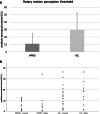Reduced vestibular perception thresholds in persistent postural-perceptual dizziness- a cross-sectional study
- PMID: 34641808
- PMCID: PMC8507224
- DOI: 10.1186/s12883-021-02417-z
Reduced vestibular perception thresholds in persistent postural-perceptual dizziness- a cross-sectional study
Abstract
Background: Persistent postural-perceptual dizziness (PPPD) is the most common functional vestibular disorder. A multisensory mismatch altered by psychological influences is considered to be an important pathophysiological mechanism. Increased cortical and subcortical excitability may play a role in the pathophysiology of PPPD. We hypothesized that decreased motion perception thresholds reflect one mechanism of the abnormal vestibular responsiveness in this disorder. We investigated the vestibular perception thresholds and the vestibular ocular reflex with a rotatory chair experiment to gain insights in the processing and adaption to vestibular provocation.
Methods: In this cross-sectional study 26 female PPPD patients and 33 healthy female age matched controls (HC) were investigated sitting in a motorized rotary chair shielded regarding visual and acoustic stimuli. The chair was rotated for 20 minutes with slowly increasing velocity to a maximum of 72°/s. We functionally tested motion perception thresholds and vegetative responses to rotation as well as vestibular-ocular reflex thresholds. We additionally investigated several psychological comorbidities (i.e. depression, anxiety, somatosensory amplification) using validated scores. Conventional dizziness scores were obtained to quantify the experienced dizziness and impact on daily life.
Results: PPPD patients showed a significant reduced vestibulo-perceptual threshold (PPPD: 10.9°/s vs. HC: 29.5°/s; p<0.001) with increased motion sensitivity and concomitant vegetative response during and after the chair rotation compared to healthy controls. The extent of increased vestibular sensitivity was in correlation with the duration of the disease (p=0.043). No significant difference was measured regarding nystagmus parameters between both groups.
Conclusion: PPPD patients showed increased vegetative response as well as decreased vestibulo-perceptual thresholds which are related to disease duration. This is of interest as PPPD might be sustained by increased vestibular excitability leading to motion intolerance and induction of dizziness when exposed to movement.
Keywords: Persistent postural-perceptual dizziness; functional vestibular disorder; motion sensitivity; vestibular perceptual threshold.
© 2021. The Author(s).
Conflict of interest statement
All authors declare that they have no competing interests.
Figures



Similar articles
-
Research Progress on the Potential Pathogenesis of Persistent Postural-Perceptual Dizziness.Brain Behav. 2025 Jan;15(1):e70229. doi: 10.1002/brb3.70229. Brain Behav. 2025. PMID: 39740787 Free PMC article. Review.
-
Visual and vestibular motion perception in persistent postural-perceptual dizziness (PPPD).J Neurol. 2024 Jun;271(6):3227-3238. doi: 10.1007/s00415-024-12255-x. Epub 2024 Mar 5. J Neurol. 2024. PMID: 38441610 Free PMC article.
-
Functional brain activity in persistent postural-perceptual dizziness (PPPD) during galvanic vestibular stimulation reveals sensitization in the multisensory vestibular cortical network.Sci Rep. 2025 Jul 27;15(1):27355. doi: 10.1038/s41598-025-11529-2. Sci Rep. 2025. PMID: 40717118 Free PMC article.
-
Postural motion perception during vestibular stimulation depends on the motion perception threshold in persistent postural-perceptual dizziness.J Neurol. 2024 Aug;271(8):4909-4924. doi: 10.1007/s00415-024-12415-z. Epub 2024 May 15. J Neurol. 2024. PMID: 38748235 Free PMC article.
-
Persistent postural-perceptual dizziness: A functional neuro-otologic disorder.Auris Nasus Larynx. 2024 Jun;51(3):588-598. doi: 10.1016/j.anl.2023.12.008. Epub 2024 Mar 29. Auris Nasus Larynx. 2024. PMID: 38552422 Review.
Cited by
-
Persistent Challenges: A Comprehensive Review of Persistent Postural-Perceptual Dizziness, Controversies, and Clinical Complexities.Cureus. 2024 May 23;16(5):e60911. doi: 10.7759/cureus.60911. eCollection 2024 May. Cureus. 2024. PMID: 38910644 Free PMC article. Review.
-
Research Progress on the Potential Pathogenesis of Persistent Postural-Perceptual Dizziness.Brain Behav. 2025 Jan;15(1):e70229. doi: 10.1002/brb3.70229. Brain Behav. 2025. PMID: 39740787 Free PMC article. Review.
-
Addressing the Overlapping Challenges of Benign Paroxysmal Positional Vertigo (BPPV) and Persistent Postural-Perceptual Dizziness (PPPD): Impacts and Integrated Management.Cureus. 2024 Oct 21;16(10):e72019. doi: 10.7759/cureus.72019. eCollection 2024 Oct. Cureus. 2024. PMID: 39440158 Free PMC article. Review.
-
Vestibular perceptual testing from lab to clinic: a review.Front Neurol. 2023 Oct 4;14:1265889. doi: 10.3389/fneur.2023.1265889. eCollection 2023. Front Neurol. 2023. PMID: 37859653 Free PMC article. Review.
References
-
- McCabe BF. The vestibular system. New York: Academic Press; 1975. Diseases of the end organ and vestibular nerve; pp. 299–302.
-
- Brandt TH, Dieterich M. Phobischer attacken-schwankschwindel, ein neues syndrom. Münch Med Wochenschr. 1986;128:247–250.
MeSH terms
LinkOut - more resources
Full Text Sources
Medical

